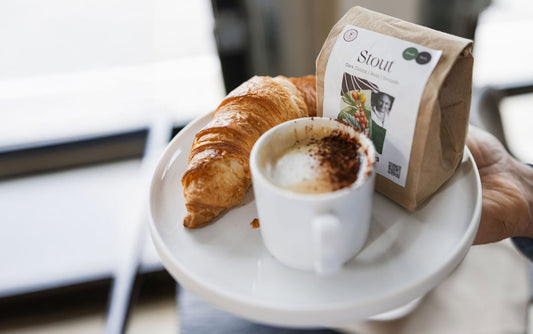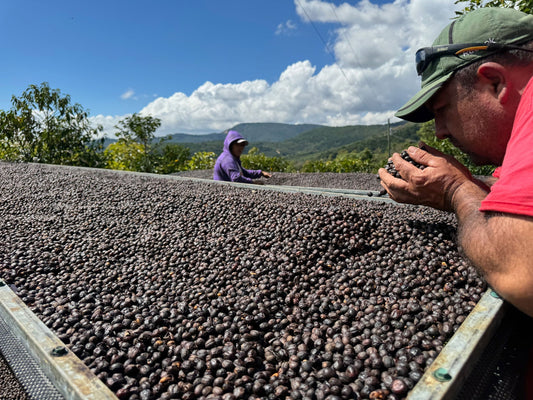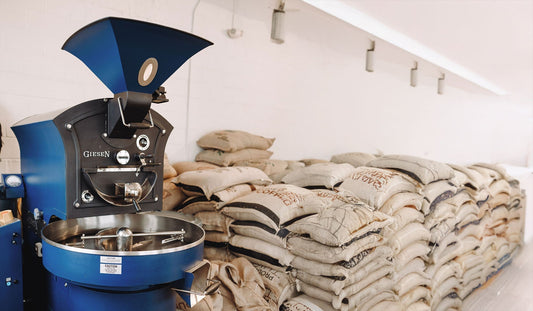Small batch coffee is not a made-up tale. It is a production choice that favors control, agility, and accountability. When it is done well, it shows in your mug.

Below is a clear, fact-based look at why small batch roasting works, where it can go wrong, and how to tell the real thing from marketing.
|
TL;DR: Small batch coffee means tighter control, fresher and tastier beans, delivering a consistent feel with accurate roast info, rest guidance, and QC. |
What Small-Batch Roasting Actually Means
Forget a single universal kilogram number.
“Small batch” is about intent more than drum size. It means roasting in lots small enough that you can minutely control heat, airflow, and rate of rise without hiding behind averages.
It means logging every roast, cupping often, and adjusting profiles quickly when a coffee drifts. It means you can roast to order instead of letting inventory sit around hoping packaging will rescue it.
In practice, roasteries that treat small batch seriously run structured quality control.
That includes reference profiles, roast logging, and cupping against standard forms so sensory feedback is comparable over time.
The Specialty Coffee Association formalized these ideas in its cupping protocol and its newer Coffee Value Assessment framework to keep evaluations systematic and transparent.
Benefit 1: Better Control Of Heat Transfer And Development
Roasting is controlled by thermal chemistry.
Aroma precursors transform through Maillard reactions and related pathways that depend on time and temperature.
Smaller batches let you manage heat and airflow with finer granularity, hit consistent end points, and avoid the common failure modes of scorching, baking, or tipping. The science is simple enough.
The Chemistry In Plain Language
When roast “energy” is well managed, key aroma compounds develop toward targets instead of wandering. That is not poetry. It is decades of kinetics work on coffee aroma formation.
How We Control It On The Roaster
On the floor, that looks like tracking rate of rise and matching reference curves, not guessing. Modern roast logging software and profile tracking make this measurable rather than mythical. Consistency is not a vibe.
It is traceable curves mapped against a profile with batch to batch checks.
Benefit 2: Faster Feedback Loops Improve Profiles
A smaller batch size means you can roast, rest, cup, and iterate quickly.

That closed loop accelerates learning and tightens variance. The point is not to chase novelty. It is to reduce process noise and get closer to what the coffee can actually be.
Why Standard Cupping Matters
When you evaluate coffees consistently using a standard cupping method, you can tell if a profile change helped or hurt and by how much.
The SCA protocols even specify roast and rest windows for sample cupping to remove confounders like uneven degassing.
Real World Agility On The Roaster
This is also where small batch roasters stand out.
We can change a development time by a few seconds based on yesterday’s cupping and push a new production roast the same day. That agility is a competitive advantage the size of a roast plant cannot buy.
Benefit 3: Roast To Order Preserves Freshness And Aroma
Aromas are volatile by definition.
They oxidize and dissipate after roasting. Packaging helps, but time still wins. Roast to order shortens the timeline from roaster to grinder.
That reduces exposure to oxygen and loss of key volatiles. Literature reviews from the Specialty Coffee Association make the point clearly.
Carbon Dioxide As A Freshness Proxy
If you like technical notes, consider carbon dioxide as a useful proxy.
Fresh roasted coffee contains significant CO₂ that slowly escapes over time. CO₂ interacts with extraction and crema and even with the way a bag inflates.
Measuring CO₂ release is a rigorous way scientists track “freshness” and shelf life. Roast smaller, ship faster, and you lean into that window rather than fighting entropy.
Benefit 4: Lower Inventory Means Lower Risk
Small batch production reduces inventory buffers.
That is not only a cash flow decision. It is a quality risk decision. Green coffee has its own stability rules. Water activity and moisture are managed to limit microbial risk and quality loss.
Specialty grade greens target low water activity to preserve quality during storage.
Turnover Beats Drift In Storage
When you roast in small runs and turn green inventory promptly, you reduce the chance that raw material drifts before you ever start the roast.
After Opening, The Clock Accelerates
On the roasted side, once a bag is opened, the atmosphere in contact with the beans changes and staling accelerates.
Studies comparing storage methods after opening show that airtight containment and package engineering matter, but the clock still runs.
Small batch roasting, paired with realistic consumption guidance, keeps you ahead of that curve.
Benefit 5: Degassing Management Improves Brewing
Fresh coffee releases CO₂ for days to weeks after roasting.

That gas changes how water flows through the puck or the bed in filter brews.
What The Science Says About CO2
Managing degassing is not hand waving. There is quantitative work on CO₂ content and on how roast conditions and degree affect degassing kinetics.
Rest Windows That Respect The Coffee
A practical takeaway is that rest windows exist, and they are coffee dependent.
Small batch roasters can cup specific lots across rest times and publish realistic brew windows rather than a one number fits all rule.
For filter coffee, a simple move like blooming exists for a reason. Pre-wetting grounds lets trapped CO₂ escape for better extraction. Fresh coffees and darker roasts usually bloom harder because they carry more gas.
That is not folklore. It is physics you can watch in your kettle steam.
Benefit 6: Profiles Tailored To Variety And Process
“Light, medium, dark” does not cut it. Natural Ethiopia does not behave like washed Colombia. Processing changes cell structure and moisture behavior.
That is also why the method you roast on matters; see coffee roasting styles for how drum, air, and hybrid approaches steer development.
How Roast Degree Affects Gas And Flow
Roast degree also drives CO₂ content and degassing behavior regardless of the exact thermal path used to get there.
In small batches, we can hold charge temperatures, airflow, and development ratios stable and adjust for the coffee in front of us, not for an average across a weekly blend run.
The result is a targeted expression of origin rather than a house flavor painted over every lot.
Aromas form and evolve at specific temperature time combinations. That is well documented in roasting kinetics research. Tuning these levers by lot is the point of small batch coffee roasting.
Benefit 7: Traceable Quality Control On Every Batch
You cannot fix what you do not measure. In small batch production, every roast is logged and cupped against a standard profile so deviations are visible and actionable.
Using reference curves lets today’s roast track yesterday’s successful curve. Rate of rise, turning point, and development ratio are compared in real time instead of by memory.
Between Batch Protocols That Stabilize The System
Stabilizing the drum between batches reduces thermal drift.
Consistent charge temperature and airflow mean fewer surprises and tighter flavor targets. The shift from a single score sheet toward a value assessment framework pushes roasters to describe what is present and what is valued. Less fluff, more evidence.
If a roaster logs profiles and cups production roasts routinely, you are more likely to get the same flavor on bag two that you enjoyed in bag one.
Benefit 8: Honest Transparency For The Customer
Smaller runs make real information possible.
Put the roast date on the bag. Share recommended rest windows by brew method. Include storage guidance once the bag is opened.
Add practical tips like chilling beans before grinding to tighten particle distribution and improve extraction consistency. That advice has peer-reviewed support and makes dialing in more repeatable.
Packaging Explained Without The Mystique
One way valves let gas escape while resisting oxygen ingress. Inert gas flushing can extend shelf life.
These are tools. The shorter the time from roast to cup, the less you need to rely on packaging to protect flavor, and that is the philosophy behind Ebru Coffee’s packaging too.
Practical Takeaway
Publish clear roast schedules, rest guidance, and storage tips.
Explain the valve and whether you use inert gas. If you recommend chilling beans before grinding, say why. Transparency turns marketing claims into instructions people can actually use.
How To Choose Small Batch Coffee That Is Actually Good
Look for a real roast date, not just a best-before stamp.
If the roaster also publishes or communicate rest guidance and sensory notes that make sense for the origin and process, that is a good sign.
If they reference standard cupping methods and talk openly about how they evaluate coffees, better still.
If they make it easy to buy specialty coffee beans online with clear roast schedules and shipping windows, you are more likely to get a bag at its best rather than a souvenir from last quarter.
If you care about genuine, freshly roasted coffee, ask how often they cup production roasts and how they log profiles. If the answer is vague, keep walking.
If you want a rapid flavor lesson at home, try this.
Brew the same coffee at day three, day ten, and day thirty after roast while keeping grind, ratio, and temperature stable.
Pay attention to flow rate and bloom behavior. You will see CO₂ and extraction change in real time. Your palate will do the rest.
Frequently Asked Questions
Is Small-Batch Roasting Always Better?
That’s a tough one to answer. It is often better controlled.
That control shows up as consistent development, faster iteration, and more honest timelines from roaster to brewer. When the operator uses the tools well, the coffee benefits.
How Fresh Is “Freshly Roasted Coffee”?
“Fresh” is not a single day.
Coffee loses volatiles and oxidizes over weeks, and packaging can slow that down. Literature reviews show nitrogen flushing and vacuum techniques can extend sensory freshness windows compared to unflushed packaging, but time still works against you.
Focus on roast date, rest windows, and storage once the bag is open.
Why Do Coffee Bags Have A Valve?
Fresh beans release CO₂. A valve lets gas out while limiting oxygen in. That prevents bag rupture and slows oxidation. It is a packaging control, not a quality badge by itself.
Does Freezing Beans Help?
Yes, if you do it right. Studies show colder beans grind to a narrower particle distribution, which can make extraction more predictable.
Store beans airtight to avoid moisture, then grind from frozen or let them come to room temperature sealed.
The Bottom Line
Small batch roasting is not romance.
It is a production choice that lets us control variables, respond fast, and get you coffee that tastes like itself. When you see the discipline behind it, not just the label, you are far more likely to end up with a bag that earns its keep.
If you care about results, look for roast to order schedules, honest data, and a roaster who publishes how they cup and why.
That is where small-batch coffee stops being a buzzword and starts being a better cup.





